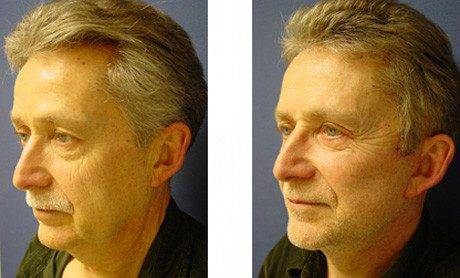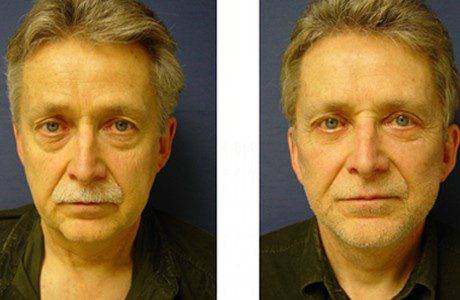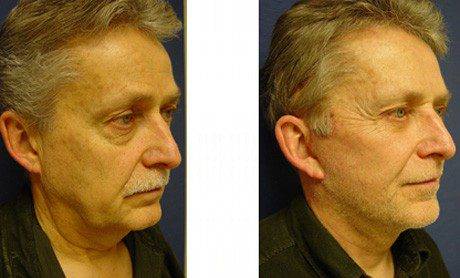


Please appreciate this 59-year-old male who has avoided the above facelift side effects, demonstrating no distortion of his sideburn and hairline and correction of his earlobes which are more natural in appearance.
Facelift Side Effects Clarified
Facelift side effects are often observed following skin-only facelifts compared to SMAS facelifts. Deformities observed with skin-only facelifts include:
- The windblown effect
- The Joker’s face
- Prominent facial scars
- Scar migration onto the neck
- Pixie ear deformity
- Lumpy facial contour
- Skin recoil and sagging recurrence
The Windblown Effect
The windblown effect describes the side effect that occurs when the excessive pull is placed on the lateral eyes resulting in the shape of the eyes becoming narrowed and pulled. Some characterize the appearance of the eyelids as “Mongolian” in appearance. This facelift side effect is caused by the excessive pull of the upper face skin during insetting. Using the dual-plane SMAS facelift will help avoid this facelift complication by avoiding undue tension on the upper face skin. Instead, the tension is positioned on the hidden underneath layer that is transparent to the external view.
The Joker Face
The joker face deformity is created by an excessive pull on the sides of the mouth resulting in the infamous Joker face that Jack Nicholson famously portrayed. This facelift side effect is again caused by the excessive pull of the skin on the lateral lip observed with the skin-only facelift technique. This deformity is vulnerable in the skin-only lift that over-dissects the subcutaneous plane centrally. In contrast, the SMAS dual plane will place most of the tension on the SMAS layer, thus sparing undue tension on the skin. This deformity is additionally avoided because the skin dissection is limited to the lateral cheek; thus, tension will not be transferred to the corner of the lips.
Prominent Facial Scars
Prominent facial scars are created by excessive tension placed on the facial skin flaps during re-draping and in-setting. The skin-only facelift is notorious for having too much tension on the facial skin. The incision line can heal suboptimally following the skin-only facelift procedure. In contrast, the dual-plane SMAS facelift placed most of the tension on the SMAS layer, thereby keeping the tension on the skin to a minimum. Since the skin has minimal tension following the SMAS facelift, the tension on the incision line is reduced and can heal optimally.
Scar Migration onto the Neck
Scar migration onto the neck is a telltale sign of the facelift when the incision line around the bottom of the facelift migrates onto the neck. The scar should fall into the groove located at the earlobe and neck junction for optimal results. When unnecessary tension is placed on the neck skin, this facelift side effect is observed as the neck pulls the incision out of the natural earlobe groove and onto the neck skin.
The Operated Appearance of the Earlobe
The earlobe has a natural and aesthetically appealing appearance as it hangs below the lowest attachment point of the ear. A prior study has identified that a hang of 5mm to 10mm is considered the ideal hang of the earlobe in both males and females.
The ideal hand of the earlobe is in contrast to an earlobe that looks operated in appearance when the natural hang is eliminated, correlating to a hang of 0 mm. When there is no hang of the earlobe, this has been characterized as a Pixie ear deformity and results in an undesirable appearance.
Scar Migration onto the Neck
This facelift side effect occurs following a skin-only facelift due to excessive neck tension placed on the earlobe attachment point. In contrast, during a SMAS facelift, the tension on the neck skin is avoided by placing most of the tension on the neck extension of the SMAS, the lateral platysma.
Lumpy Facial Contour
A lumpy facial contour is a facelift side effect that occurs when the deeper tissues are not separately undermined and lifted before the skin lift. This facelift deformity is observed following a skin-only facelift. Instead, the dual-plane SMAS facelift allows for optimal re-draping of the underlying deeper tissues before pulling up the skin layer. This facelift side effect is avoided when the skin layer is re-draped following the draping of the deeper tissues.
Skin Recoil and Sagging Recurrence
Skin recoil and sagging recurrence are responsible for losing the gains you may notice immediately following facelift surgery. This side effect is most common after a skin-only facelift since all the tension is on the skin layer. Instead, the dual-plane SMAS facelift eliminates the skin tension by placing the leverage on the deeper fascial SMAS layer. You will minimize the risk of skin recoil by eliminating excess skin tension.
Facelift Side Effects Summary
In conclusion, there are several facelift side effects that stem from facelifts that are performed using the skin-only technique. This is in contrast to facelifts performed using the extended SMAS technique. The latter technique utilizes an underlying tissue plane, namely the superficial fascia, to achieve the leverage needed to gain the pull to achieve the desired effects without creating unnecessary tension. By avoiding unnecessary tension, the discussed side effects can be avoided. If you want an optimal facelift that minimizes facelift side effects, we encourage you to consult a SurgiSculpt surgeon.

